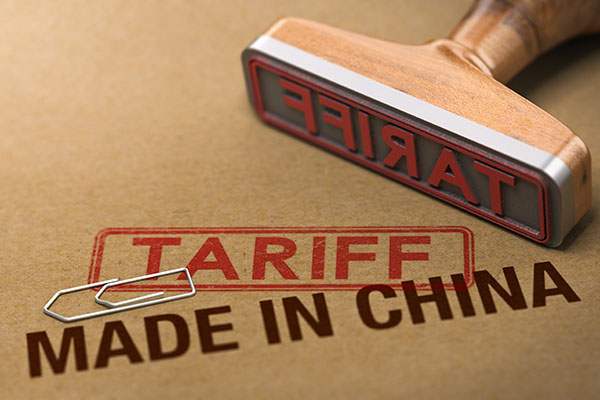Agriculture Transportation Coalition share concerns over tariffs
China can also impose non-tariff barriers that will hurt U.S. agricultural shippers.

While most of the alarm over trade war escalation with China has been expressed by leading U.S. retailers and manufacturers dependent on imports, another prominent voice is being raised by the nation’s largest association representing agricultural exporters.
“Most of our ag and forest products are subject to China's retaliatory tariffs,” says Peter Friedmann, executive director of the Washington, D.C.-based Agriculture Transportation Coalition (AgTC). “What will China do now? Make concessions on intellectual property and subsidies demanded by the U.S. or continue to play a waiting game by increasing existing punitive tariffs on our ag exports?”
Friedmann notes that China can also impose non-tariff barriers that will hurt U.S. ag shippers. Non-Tariff Barriers (NTBs) refer to restrictions that result from prohibitions, conditions, or specific market requirements that make exports more difficult or costlier. NTBs arise from different measures taken by governments and authorities in the form of laws, regulations, policies, conditions, restrictions or specific requirements, and private sector business practices, or prohibitions that protect the domestic industries from foreign competition.
“As the AgTC prepares for its 31st annual meeting next month in Tacoma, we are going to be taking a look at ‘the new normal’ relationships with China,” says Friedmann. “Erin Ennis, vice president of the U.S.-China Business Council, will examine the complexity of present and forecasted complexity for ocean carriage in the trade lane.”
A whole host of other urgent Pacific Rim issues will also be addressed at the AgTC conference, including port competitiveness for ag business. U.S. west coast ports, for example, are at risk of losing even more market share to ports in the nation’s gulf and southeast if new efficiencies in terminal operations are not put into practice.
“When the carriers began introducing mega vessels to deploy to the Pacific Rim, they did not consider the pressure this would place on terminals and truckers,” Friedmann says. “This is the main reason there’s so many chokepoints.”
And time may be running out for U.S. west coast ports, as rivals continue to invest in rail networks, warehousing, and dockside infrastructure.
“Cargo will always follow the path of least resistance,” Friedmann adds. “It’s like the inexorable flow of water, which finds a way to move beyond any physical barrier. Look for more inbound vessel calls to foreign West Coast ports in Canada and Mexico if change does not occur soon.”
Furthermore, exporters want U.S. west coast ports to attract more inbound traffic for another key reason: back haul container capacity.
“Our shippers can’t be sending a truck out to Savannah for an empty box to ship hay from Tangent, Oregon to China,” Friedmann says. “There’s simply not margin in making such a move, because if China doesn’t buy hay from us, they’ll get it from Australia or Canada, or someplace else.”
Which brings us the AgTC’s current bête noire: detention and demurrage charges.
“This expense as become an overwhelming burden on U.S. exporters,” he says. “They reflect the ongoing dysfunctional relationship many terminals have with ocean carriers bringing new massive cargoes to West Coast ocean cargo gateways.”
Friedmann allows that the concept of these fees made sense in earlier days, as they were designed as an incentive for exporters and their transport stakeholders to work together on cargo velocity solutions. Given the current state of congestion, however, the fees now represent a penalty for the shipper.
Finally, the much-anticipated AgTC annual “Ocean Carrier Perfomance Survey” will be made available at the annual meeting.
“The survey ranks the different ocean carriers on such criteria as availability of equipment, availability of space on vessels, document accuracy and efficiency,” says Friedmann. “As shippers of time-critical commodities, we’re especially sensitive to a carrier’s willingness to accept export documentation as late as possible and adhere to advertised versus actual vessel schedule and transit time.”

Article Topics
Global Trade News & Resources
UPS reports first quarter earnings decline Supply Chain Stability Index sees ‘Tremendous Improvement’ in 2023 Descartes March Global Shipping Report highlights ongoing steady volume momentum U.S.-bound import growth track remains promising, notes Port Tracker report EU Update 2024: Crises lead to growth Examining the impact of the Taiwan earthquake on global supply chain operations Descartes announces acquisition of OCR Services Inc. More Global TradeLatest in Logistics
Shipment and expenditure decreases trend down, notes Cass Freight Index March trucking tonnage trends down, reports ATA FTR Shippers Conditions Index enters negative territory DAT March Truckload Volume Index sees modest March gains National diesel average, for week of April 22, is down for the second straight week UPS reports first quarter earnings decline LM Podcast Series: Assessing the freight transportation and logistics markets with Tom Nightingale, AFS Logistics More LogisticsAbout the Author
Subscribe to Logistics Management Magazine

Find out what the world's most innovative companies are doing to improve productivity in their plants and distribution centers.
Start your FREE subscription today.
April 2023 Logistics Management

Latest Resources














